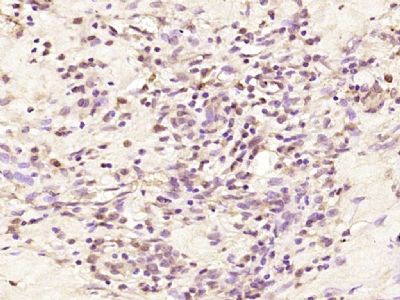LOR/Loricrin Polyclonal Antibody
Purified Rabbit Polyclonal Antibody (Pab)
- SPECIFICATION
- CITATIONS
- PROTOCOLS
- BACKGROUND

Application
| IHC-P, IHC-F, IF, ICC, E |
|---|---|
| Primary Accession | P23490 |
| Host | Rabbit |
| Clonality | Polyclonal |
| Calculated MW | 26 KDa |
| Physical State | Liquid |
| Immunogen | KLH conjugated synthetic peptide derived from human LOR/Loricrin |
| Epitope Specificity | 251-312/312 |
| Isotype | IgG |
| Purity | affinity purified by Protein A |
| Buffer | 0.01M TBS (pH7.4) with 1% BSA, 0.02% Proclin300 and 50% Glycerol. |
| SUBCELLULAR LOCATION | Cytoplasm. Nucleus;nucleoplasm. |
| Post-translational modifications | Substrate of transglutaminases. Some glutamines and lysines are cross-linked to other loricrin molecules and to SPRRs proteins. Contains inter- or intramolecular disulfide-bonds. |
| DISEASE | Defects in LOR are a cause of progressive symmetric erythrokeratodermia (PSEK) [MIM:133200]. Erythrokeratodermas are a group of disorders characterized by widespread erythematous plaques, either stationary or migratory, associated with features that include palmoplantar keratoderma. PSEK is characterized by erythematous and hyperkeratotic plaques. Defects in LOR are the cause of Vohwinkel syndrome with ichthyosis (VSI) [MIM:604117]; also known as loricrin keratoderma (LK) or mutilating keratoderma with ichthyosis. VSI is an ichthyotic variant of Vohwinkel syndrome (VS) characterized by progressive symmetric erythrokeratoderma or congenital ichthyosiform erythroderma born as a collodion baby. Common clinical features include hyperkeratosis of the palms and soles with digital constriction. |
| Important Note | This product as supplied is intended for research use only, not for use in human, therapeutic or diagnostic applications. |
| Background Descriptions | This gene encodes loricrin, a major protein component of the cornified cell envelope found in terminally differentiated epidermal cells. Mutations in this gene are associated with Vohwinkel's syndrome and progressive symmetric erythrokeratoderma, both inherited skin diseases. [provided by RefSeq, Jul 2008] |
| Gene ID | 4014 |
|---|---|
| Other Names | Loricrin, LORICRIN (HGNC:6663), LOR, LRN |
| Dilution | IHC-P=1:100-500,IHC-F=1:100-500,ICC=1:100-500,IF=1:100-500,ELISA=1:5000-10000 |
| Format | 0.01M TBS(pH7.4), 0.09% (W/V) sodium azide and 50% Glyce |
| Storage | Store at -20 ℃ for one year. Avoid repeated freeze/thaw cycles. When reconstituted in sterile pH 7.4 0.01M PBS or diluent of antibody the antibody is stable for at least two weeks at 2-4 ℃. |
| Name | LORICRIN (HGNC:6663) |
|---|---|
| Synonyms | LOR, LRN |
| Function | Major keratinocyte cell envelope protein. |
| Cellular Location | Cytoplasm. Nucleus, nucleoplasm. |

Thousands of laboratories across the world have published research that depended on the performance of antibodies from Abcepta to advance their research. Check out links to articles that cite our products in major peer-reviewed journals, organized by research category.
info@abcepta.com, and receive a free "I Love Antibodies" mug.
Provided below are standard protocols that you may find useful for product applications.
If you have used an Abcepta product and would like to share how it has performed, please click on the "Submit Review" button and provide the requested information. Our staff will examine and post your review and contact you if needed.
If you have any additional inquiries please email technical services at tech@abcepta.com.













 Foundational characteristics of cancer include proliferation, angiogenesis, migration, evasion of apoptosis, and cellular immortality. Find key markers for these cellular processes and antibodies to detect them.
Foundational characteristics of cancer include proliferation, angiogenesis, migration, evasion of apoptosis, and cellular immortality. Find key markers for these cellular processes and antibodies to detect them. The SUMOplot™ Analysis Program predicts and scores sumoylation sites in your protein. SUMOylation is a post-translational modification involved in various cellular processes, such as nuclear-cytosolic transport, transcriptional regulation, apoptosis, protein stability, response to stress, and progression through the cell cycle.
The SUMOplot™ Analysis Program predicts and scores sumoylation sites in your protein. SUMOylation is a post-translational modification involved in various cellular processes, such as nuclear-cytosolic transport, transcriptional regulation, apoptosis, protein stability, response to stress, and progression through the cell cycle. The Autophagy Receptor Motif Plotter predicts and scores autophagy receptor binding sites in your protein. Identifying proteins connected to this pathway is critical to understanding the role of autophagy in physiological as well as pathological processes such as development, differentiation, neurodegenerative diseases, stress, infection, and cancer.
The Autophagy Receptor Motif Plotter predicts and scores autophagy receptor binding sites in your protein. Identifying proteins connected to this pathway is critical to understanding the role of autophagy in physiological as well as pathological processes such as development, differentiation, neurodegenerative diseases, stress, infection, and cancer.


